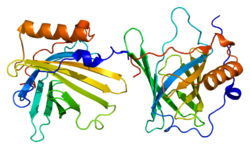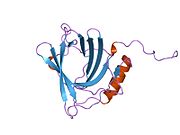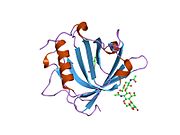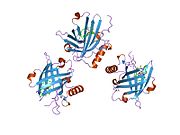Lipocalin-2 (LCN2), also known as oncogene 24p3 or neutrophil gelatinase-associated lipocalin (NGAL), is a protein that in humans is encoded by the LCN2 gene. NGAL is involved in innate immunity by sequestering iron and preventing its use by bacteria, thus limiting their growth. It is expressed in neutrophils and in low levels in the kidney, prostate, and epithelia of the respiratory and alimentary tracts. NGAL is used as a biomarker of kidney injury.
Function
The binding of NGAL to bacterial siderophores is important in the innate immune response to bacterial infection. Upon encountering invading bacteria, the toll-like receptors on immune cells stimulate the synthesis and secretion of NGAL. Secreted NGAL then limits bacterial growth by sequestering iron-containing siderophores. Lipocalin-2 binds, next to bacterial siderophores, also to the mammalian siderophore 2,5-dihydroxybenzoic acid (2,5-DHBA). This complex ensures that excess free iron does not accumulate in the cytoplasm. Mammalian cells lacking 2,5-DHBA accumulate abnormal intracellular levels of iron leading to high levels of reactive oxygen species. Lipocalin-2 also functions as a growth factor and participates in synaptic plasticity.
Clinical significance
As NGAL is protease resistant and has a low molecular weight, it is excreted and detectable in urine. Injured epithelial cells in the kidney secrete a monomeric form of NGAL, whereas activated neutrophils secrete a dimeric form. It has therefore been hypothesized that classification of NGAL form could improve acute kidney injury (AKI) diagnostics, by distinguishing NGAL of inflammatory origin from that of renal origin. In AKI patients, NGAL levels are however elevated in both blood and urine within two hours of injury and plasma NGAL been shown to be predictive of dialysis need. NGAL has also be associated with chronic kidney disease, contrast induced nephropathy, kidney transplant, and mortality.
Kidney health is most frequently measured by serum creatinine. Serum creatinine is a marker of kidney function, whereas NGAL is a marker of kidney injury. NGAL levels are a more precise and sensitive marker for diagnosing AKI than serum creatinine levels. Therefore, monitoring NGAL levels reduces delayed AKI diagnosis and treatment. Using a more sensitive and specific marker allows for earlier diagnosis, correct responses to AKI, and reduced risk of morbidity and mortality.
The NGAL level measured in an individual is proportional to the severity of the AKI. Individuals positive for NGAL tend to have higher incidence of renal replacement therapy and have higher rates of in-hospital mortality, both in the presence and the absence of serum creatinine. Therefore, an individual may have AKI without the presence of serum creatinine.
The ability to diagnose AKI before acute kidney failure is financially beneficial and favorable for preventative health measures. More than 10% of people in the United States will develop some kind of chronic kidney disease (CKD), with higher incidences for individuals that suffer from obesity, elevated cholesterol, and a family history of CKD. There is no point of return once there is a significant injury to the kidney; therefore, early diagnosis of kidney injury is important for preventing AKI. Using NGAL as a biomarker can lower hospital costs because fewer patients will reach a critical stage in kidney injury. Ultimately, diagnosis of AKI with NGAL can reduce the time a patient stays in a hospital. For example, the early diagnosis of AKI with NGAL as a biomarker can help a patient avoid kidney dialysis.
LCN2 was found to be upregulated in postmortem human brains with Alzheimer's disease. Application of LCN2 to in vitro 3D human astroglia, it reduces neurogenic potential and enhances reactive states. LCN2 activity can be blocked with NGFR signaling.
Laboratory measurement
Renal expression of NGAL increases in the kidneys after injury for a variety of reasons. The level of NGAL in the urine and plasma increases within 2 hours of kidney injury. It is possible to measure NGAL in serum or urine in the range of 25 to 5,000 ng/mL by current laboratory tests. Low levels for NGAL have been considered to be 200 ng/mL, medium levels 400 ng/mL, and high levels 800 ng/mL.
A study on children with pediatric cardiopulmonary bypass operations showed that urinary NGAL concentrations above 50 ng/mL 2 hours after surgery is indicative of serum creatinine levels 50% over basal values. Normally, children tend to have almost undetectable levels of NGAL. Therefore, studies that include children are considered to be “pure.” Adult patients presenting for cardiopulmonary bypass surgery are not considered to be “pure” in NGAL studies because adults often have other disorders such as inflammatory conditions, which can cause slight increases in NGAL.
AKI studies investigating the use of NGAL as a biomarker often compare serum creatinine and NGAL production. Unfortunately, serum creatinine production is variable and can reflect hemodynamic variation in the glomerular filtration rate formerly known as prerenal azotemia; therefore, the comparison is not always reliable because creatinine and NGAL measure different components of renal (dys)function. The demonstration that NGAL does not rise in the setting of transient changes in creatinine can help clinicians determine whether changes in creatinine reflect kidney damage or rather only non specific or mild functional changes in kidney function.
Lipocalin-2 (NGAL) is typically assessed for clinical or research purposes using ELISA or immunoturbidimetric assays.
Lipocalin-2 (NGAL) was approved by the US FDA (Dec 7, 2023) to detect injury leading to worsening renal function. NGAL was approved previously in Japan (2017) and Europe to detect kidney damage in patients.
See also
References
- ^ GRCh38: Ensembl release 89: ENSG00000148346 – Ensembl, May 2017
- ^ GRCm38: Ensembl release 89: ENSMUSG00000026822 – Ensembl, May 2017
- "Human PubMed Reference:". National Center for Biotechnology Information, U.S. National Library of Medicine.
- "Mouse PubMed Reference:". National Center for Biotechnology Information, U.S. National Library of Medicine.
- Kjeldsen L, Johnsen AH, Sengeløv H, Borregaard N (May 1993). "Isolation and primary structure of NGAL, a novel protein associated with human neutrophil gelatinase". The Journal of Biological Chemistry. 268 (14): 10425–32. doi:10.1016/S0021-9258(18)82217-7. PMID 7683678.
- Chan P, Simon-Chazottes D, Mattei MG, Guenet JL, Salier JP (September 1994). "Comparative mapping of lipocalin genes in human and mouse: the four genes for complement C8 gamma chain, prostaglandin-D-synthase, oncogene-24p3, and progestagen-associated endometrial protein map to HSA9 and MMU2". Genomics. 23 (1): 145–50. doi:10.1006/geno.1994.1470. PMID 7829063.
- ^ Cowland JB, Borregaard N (October 1997). "Molecular characterization and pattern of tissue expression of the gene for neutrophil gelatinase-associated lipocalin from humans". Genomics. 45 (1): 17–23. doi:10.1006/geno.1997.4896. PMID 9339356.
- Yang J, Goetz D, Li JY, Wang W, Mori K, Setlik D, et al. (November 2002). "An iron delivery pathway mediated by a lipocalin". Molecular Cell. 10 (5): 1045–56. doi:10.1016/S1097-2765(02)00710-4. PMID 12453413.
- Friedl A, Stoesz SP, Buckley P, Gould MN (July 1999). "Neutrophil gelatinase-associated lipocalin in normal and neoplastic human tissues. Cell type-specific pattern of expression". The Histochemical Journal. 31 (7): 433–41. doi:10.1023/A:1003708808934. PMID 10475571. S2CID 19448533.
- Devarajan P (June 2010). "Review: neutrophil gelatinase-associated lipocalin: a troponin-like biomarker for human acute kidney injury". Nephrology. 15 (4): 419–28. doi:10.1111/j.1440-1797.2010.01317.x. PMID 20609093. S2CID 24061863.
- Flo TH, Smith KD, Sato S, Rodriguez DJ, Holmes MA, Strong RK, et al. (December 2004). "Lipocalin 2 mediates an innate immune response to bacterial infection by sequestrating iron". Nature. 432 (7019): 917–21. Bibcode:2004Natur.432..917F. doi:10.1038/nature03104. PMID 15531878. S2CID 4422697.
- ^ Schmidt-Ott KM, Mori K, Li JY, Kalandadze A, Cohen DJ, Devarajan P, Barasch J (February 2007). "Dual action of neutrophil gelatinase-associated lipocalin". Journal of the American Society of Nephrology. 18 (2): 407–13. doi:10.1681/ASN.2006080882. PMID 17229907.
- Berger T, Togawa A, Duncan GS, Elia AJ, You-Ten A, Wakeham A, et al. (February 2006). "Lipocalin 2-deficient mice exhibit increased sensitivity to Escherichia coli infection but not to ischemia-reperfusion injury". Proceedings of the National Academy of Sciences of the United States of America. 103 (6): 1834–9. Bibcode:2006PNAS..103.1834B. doi:10.1073/pnas.0510847103. PMC 1413671. PMID 16446425.
- Devireddy LR, Hart DO, Goetz DH, Green MR (June 2010). "A mammalian siderophore synthesized by an enzyme with a bacterial homolog involved in enterobactin production". Cell. 141 (6): 1006–17. doi:10.1016/j.cell.2010.04.040. PMC 2910436. PMID 20550936.
- McEwen BS, Bowles NP, Gray JD, Hill MN, Hunter RG, Karatsoreos IN, Nasca C (October 2015). "Mechanisms of stress in the brain". Nature Neuroscience. 18 (10): 1353–63. doi:10.1038/nn.4086. PMC 4933289. PMID 26404710.
- ^ Uttenthal LO (April 2007). "NGAL: How Useful Is the New Marker of Kidney Damage?" (PDF). CLI.
- Mårtensson J, Xu S, Bell M, Martling CR, Venge P (October 2012). "Immunoassays distinguishing between HNL/NGAL released in urine from kidney epithelial cells and neutrophils". Clinica Chimica Acta. 413 (19–20): 1661–1667. doi:10.1016/j.cca.2012.05.010. PMID 22609864.
- Bennett M, Dent CL, Ma Q, Dastrala S, Grenier F, Workman R, et al. (May 2008). "Urine NGAL predicts severity of acute kidney injury after cardiac surgery: a prospective study". Clinical Journal of the American Society of Nephrology. 3 (3): 665–73. doi:10.2215/CJN.04010907. PMC 2386703. PMID 18337554.
- ^ Engström J, Koozi H, Didriksson I, Larsson A, Friberg H, Frigyesi A, Spångfors M (March 2024). "Plasma neutrophil gelatinase-associated lipocalin independently predicts dialysis need and mortality in critical COVID-19". Scientific Reports. 14 (1): 6695. doi:10.1038/s41598-024-57409-z. PMC 10954663. PMID 38509165.
- Goldstein SL (December 2011). "Acute kidney injury biomarkers: renal angina and the need for a renal troponin I". BMC Medicine. 9: 135. doi:10.1186/1741-7015-9-135. PMC 3287120. PMID 22189039.
- Han WK, Wagener G, Zhu Y, Wang S, Lee HT (May 2009). "Urinary biomarkers in the early detection of acute kidney injury after cardiac surgery". Clinical Journal of the American Society of Nephrology. 4 (5): 873–82. doi:10.2215/CJN.04810908. PMC 2676184. PMID 19406962.
- Lerma EV (2012). "Novel Biomarkers of Renal Function". Medscape.
- ^ Haase M, Devarajan P, Haase-Fielitz A, Bellomo R, Cruz DN, Wagener G, et al. (April 2011). "The outcome of neutrophil gelatinase-associated lipocalin-positive subclinical acute kidney injury: a multicenter pooled analysis of prospective studies". Journal of the American College of Cardiology. 57 (17): 1752–61. doi:10.1016/j.jacc.2010.11.051. PMC 4866647. PMID 21511111.
- Collister D, Pannu N, Ye F, James M, Hemmelgarn B, Chui B, et al. (November 2017). "Health Care Costs Associated with AKI". Clinical Journal of the American Society of Nephrology. 12 (11): 1733–1743. doi:10.2215/CJN.00950117. PMC 5672961. PMID 29051143.
- ^ Siddiqui T, Cosacak MI, Popova S, Bhattarai P, Yilmaz E, Lee AJ, Min Y, Wang X, Allen M, İş O, Atasavum ZT, Rodriguez-Muela N, Vardarajan BN, Flaherty D, Teich AF, Santa-Maria I, Freudenberg U, Werner C, Tosto G, Mayeux R, Ertekin-Taner N, Kizil C (July 2023). "Nerve growth factor receptor (Ngfr) induces neurogenic plasticity by suppressing reactive astroglial Lcn2/Slc22a17 signaling in Alzheimer's disease". npj Regenerative Medicine. 8 (1): 33. doi:10.1038/s41536-023-00311-5. PMC 10333226. PMID 37429840.
- ^ Lippi G, Aloe R, Storelli A, Cervellin G, Trenti T (December 2011). "Evaluation of NGAL Test™, a fully-automated neutrophil gelatinase-associated lipocalin (NGAL) immunoassay on Beckman Coulter AU 5822". Clinical Chemistry and Laboratory Medicine. 50 (9): 1581–4. doi:10.1515/cclm.2011.839. PMID 22962213. S2CID 39364947.
- Krawczeski CD, Woo JG, Wang Y, Bennett MR, Ma Q, Devarajan P (June 2011). "Neutrophil gelatinase-associated lipocalin concentrations predict development of acute kidney injury in neonates and children after cardiopulmonary bypass". The Journal of Pediatrics. 158 (6): 1009–1015.e1. doi:10.1016/j.jpeds.2010.12.057. PMID 21300375.
| PDB gallery | |
|---|---|
|












